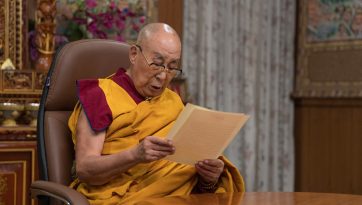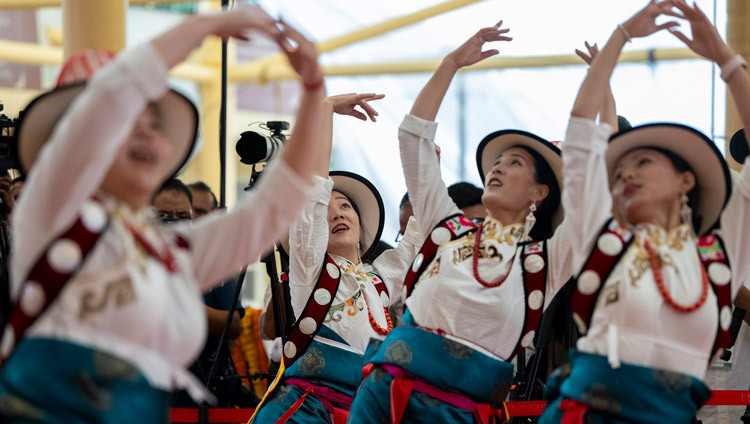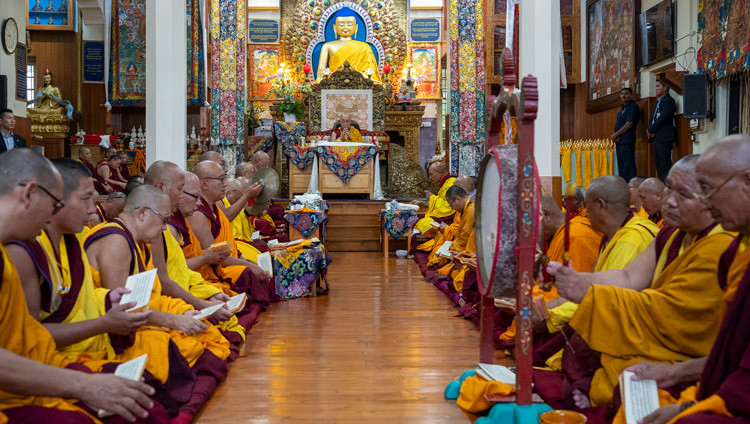8. What are some of your new initiatives in education and what is the current status of the transfer of CTSA-run schools to the CTA?
Education continues to be a top priority of our administration. Our literacy rate of 84% is better than that of many south Asian countries. We want to provide a supportive environment where our schools, students and teachers can excel. Some of the key programs we have launched include:
· Incentivized Scholarship: The incentivized scholarship to offer higher funding for higher scores was initiated to inspire students to work harder and perform at higher levels.
Students from families living below the poverty line (nyamthak) now receive special scholarships as long as they score a minimum of 40% in their board exams.
Gaden Phodrang student merit awards have been increased from three to nine and the top three performers in science, arts and commerce receive INR 20,000/15,000/10,000 respectively.
A new annual Sikyong scholarship of INR 100,000 will be awarded to any student scoring 95% or higher in XIIth grade board exams.
This year’s XIIth grade board results are also encouraging. The number of students scoring 90% rose from 4 in the previous year to 13. Students scoring at least 70% rose from 242 to 345. Tenzin Chokyi, the first recepient of the Sikyong scholarship, scored a total of 95.4% in the All India Senior School Certificate Examination – the highest to date in the history of Tibetan education in exile.
· New College Opportunities in the United States: CTA and a partner organization convened a meeting in Boston on October 14, 2012 which brought together His Holiness the Dalai Lama and more than 60 deans and admission officers from some of the top American schools including Harvard, Stanford, MIT, Caltech, Princeton and Yale. We are hopeful that the number of Tibetan students seeking and gaining admissions to high-ranking universities will increase in the coming years. CTA will continue to reach out to university officials in the U.S. and elsewhere across the globe.
· Bhuntar, Centre for teacher education: We opened a centre for teacher education at Bhuntar, an off-campus branch of Central University of Tibetan Studies, Sarnath. The aim is to give teachers a strong foundation in content and pedagogy firmly grounded in moral ethics and human values.
· Education Advisory Committee meeting: The first-ever Education Advisory Council meeting was held on 5-6 June 2013. Experts in the field of education, including Indian Padma Shri recipients, attended the meeting as committee members.
· National Geographic Explorers (Nat Geo) Program: A year-round science, environmental science and English learning programs were introduced for students of class VI to X in three Sambhota schools (Peton, Paonta and Chauntra) and two TCV schools ( Suja and Chauntra) in July 2013. This collaborative effort between the Department of Education and the Nat Geo Explorers (NGX) Program, based in the U.S., aims to improve English language proficiency of Tibetan students; and to improve the teaching and learning of environmental science.
As regards the CTSA schools transfer, we are close to finalizing the document detailing the modalities of the transfer. We are aware of the challenges related to the transition and will make every effort possible to ensure a transparent and successful transfer.
9. What are your thoughts on the state of gender equality in the exile Tibetan community and what measures has your Administration taken in this area?
The 14th Kashag is fully committed to gender equality and supports the welfare and overall advancement of Tibetan women. Though there is still much to do, I’m pleased to report that we have made some progress. This includes the fact that female Kalons run two of CTA’s largest departments – Department of Home, and Department of Information and International Relations. Also, women representation in the 15th Tibetan Parliament-in-Exile has increased from 8 to 12 compared to the previous parliament. Women comprise 36.5% of the CTA workforce.
Yes, the number of women in senior CTA leadership positions is still much too small. This is due to the fact that promotion within the CTA service is exclusively based on seniority. However, now that more women are applying and being hired by CTA, we are confident this will lead to an increased number of women in key positions.
To gain a better understanding of the gender situation in the exile community, the Social and Resource Development desk (SARD) of Department of Finance has recently published a report titled The Status of Women.
In the exile Tibetan community-at-large, I’m pleased to see Tibetan girls excelling academically. In the recent All India Secondary School Certificate Examination conducted by CBSE, the girls outperformed the boys in clearing the high school board exams (88.63% to 85.96%), attended colleges in larger numbers and also received a larger share of CTA scholarships. In 2011, 125 female students received undergraduate scholarships as compared to 53 male. Post graduate scholarships went to 52 women and 21 men. In 2012, the numbers were 125 female to 108 male for undergraduate scholarships and 52 female to 20 males for post graduates. This accomplishment is comparable to economically advanced countries because, even in the U.S., the female representation outpaced male representation at the college level only recently.
Let me also comment on the Tenzingang incident, a most unfortunate case of gender violence. This incident happened in June 2011, two months before the 14th Kashag took over. By then, an agreement had already been mediated amongst concerned parties by the local community. The aggrieved woman, till date, refused to file a legal complaint despite our and others repeated efforts. As per the court of law, if a victim refuses to file a case, one cannot do much. Through the CTA’s Department of Health the previous Kashag extended all necessary medical and other assistance to the aggrieved woman.
As per the resolution passed in the Tibetan Parliament-in-Exile, the Kashag in April 2012 sent out a circular notifying local representatives of all Tibetan settlements to exercise gender sensitivity in any decision-making process. The dedicated staff of Department of Home and Kalon Gyari Dolma continue to create awareness among the Tibetan settlement officers on gender sensitization.
10. Lastly, what is the current status of the Canada Tibetan re-settlement program and could you please provide an update on the U.S. Immigration Bill that has a provision for 5000 visas for Tibetans?
We are grateful to the Canadian government for accepting 1000 Tibetan refugees from Arunachal Pradesh as permanent residents under a special program. This opportunity became possible after His Holiness the Dalai Lama visited Canada in 2008. In the first lottery, 890 people were selected, including 409 applicants under “Single” category and 481 under the “Family” category. The first batch of 204 applicants is expected to leave for Canada in the fall of 2013. CTA provided the settlement resident data, allocated the number of seats based on the population of various camps, and monitored the entire process. The actual process of preparing a list of people, organizing the lottery, etc. was conducted by the camp representatives in conjunction with Project Tibet Society, the Canadian organization coordinating the resettlement program.
Provision for 5000 visas to the U.S. for displaced Tibetans over a three-year period was initiated as an amendment to a larger immigration reform bill currently under consideration in the U.S. Congress. Senator Diane Feinstein sponsored the amendment which passed the U.S. Senate with broad bipartisan support. However, the fate of the Tibetan provision is tied to the outcome of the larger immigration bill. The House of Representatives, controlled by the Republican Party, has criticized the comprehensive immigration bill and announced that they will come up with their own series of immigration-related bills. Hence, it remains uncertain whether or not the Congress will pass the immigration reform bill.
Would you like to share any final thoughts?
I, on behalf of the Kashag, want to express my deep gratitude for the continuing support of Tibetans both inside and outside Tibet. Active participation by individuals and civic groups is crucial for a vibrant democracy. We welcome diverse opinions and feedback on our various initiatives and policies while at the same time, encouraging civil and respectful discourse as we maintain our unity.
The enduring spirit of Tibetans in Tibet, the unity of all Tibetans, and the guiding presence of His Holiness the Dalai Lama will help us achieve our long cherished goal that all Tibetans enjoy the freedom and dignity which we deserve and is our right.
I would like to thank all my colleagues in the Kashag and the CTA staff for their support and dedication. We continue to meet adversity with exceptional unity, resilience, and dignity. I pay tribute to all those who have sacrificed their lives for Tibet. I fervently pray for the long life of His Holiness the Dalai Lama.
For those interested in keeping abreast of the latest developments of the Central Tibetan Administration and the Sikyong’s work, please visit www.tibet.net, LIKE the Sikyong Facebook page (https://www.facebook.com/sikyong.lobsang.sangay), and follow the Sikyong on Twitter @drlobsangsangay.)
TASHI DELEK.




